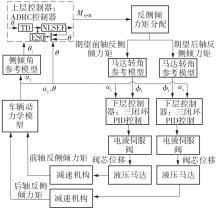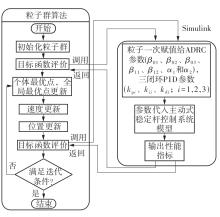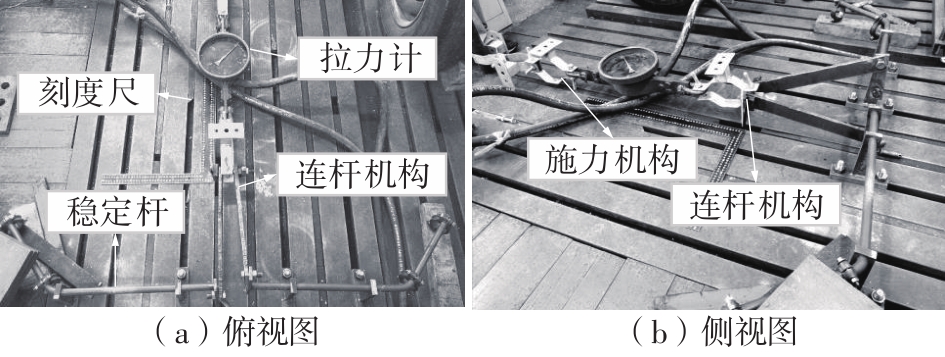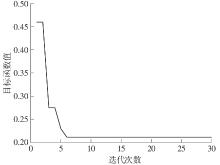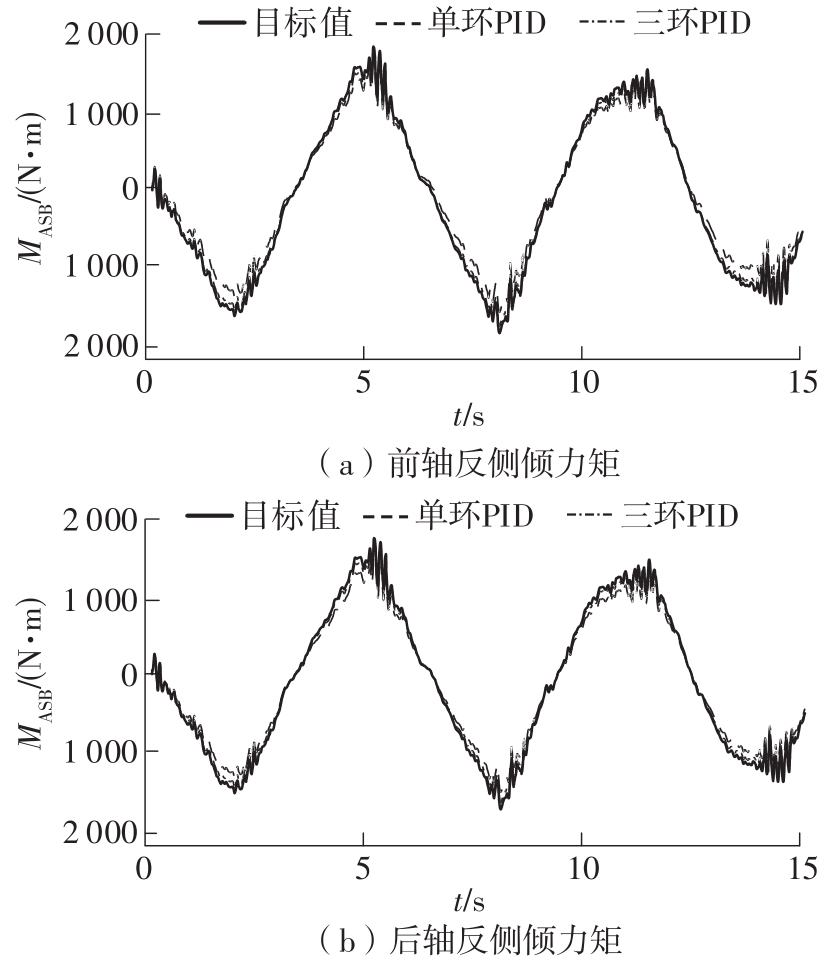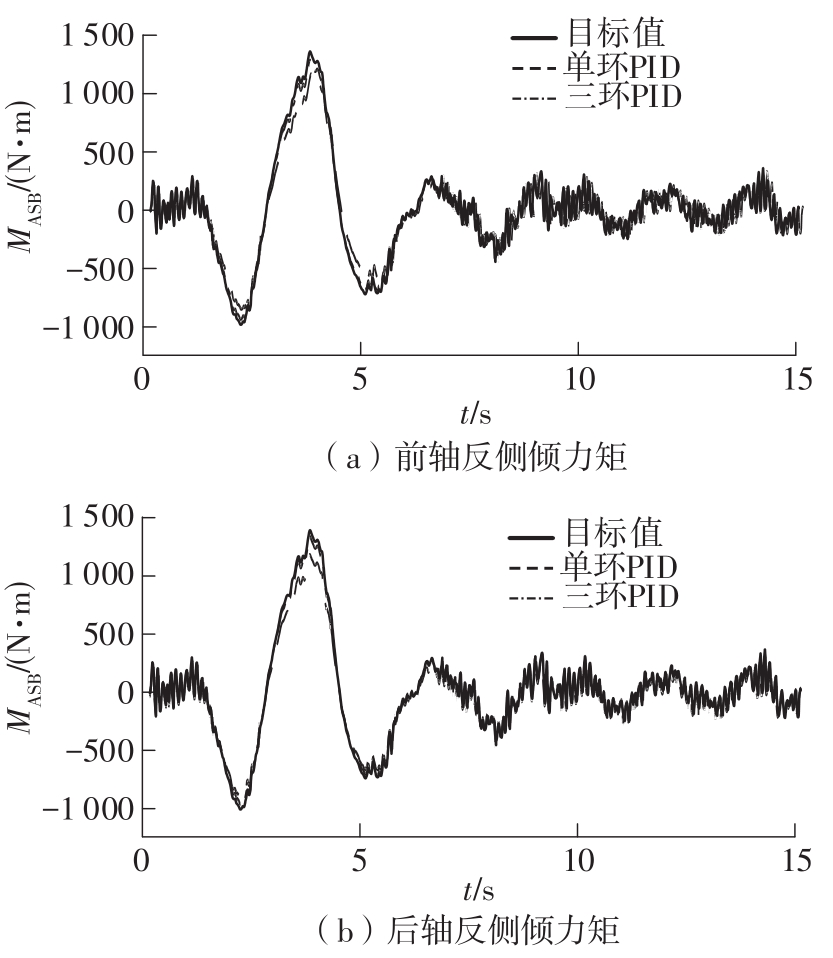Journal of South China University of Technology(Natural Science Edition) ›› 2023, Vol. 51 ›› Issue (6): 52-61.doi: 10.12141/j.issn.1000-565X.220535
Special Issue: 2023年交通运输工程
• Traffic & Transportation Engineering • Previous Articles Next Articles
Active Disturbance Rejection Control of Active Stabilizer System Based on Particle Swarm Optimization
ZHAO Qiang1 LIU Chuanwei1 ZHANG Na2 ZHU Baoquan1 XIE Chunli1
- 1.College of Mechanical and Electrical Engineering,Northeast Forestry University,Harbin 150040,Heilongjiang,China
2.School of Electrical and Control Engineering,Heilongjiang University of Science and Technology,Harbin 150022,Heilongjiang,China
-
Received:2022-08-19Online:2023-06-25Published:2022-12-06 -
Contact:刘传卫(1994-),男,硕士生,主要从事车辆动力学及控制研究。 E-mail:1436255322@qq.com -
About author:赵强(1971-),男,教授,博士生导师,主要从事车辆动力学及控制研究。E-mail:zhaoqiang@nefu.edu.cn -
Supported by:the Key Projects of National Key Research & Development Program of China(2017YFC0803901);the Heilongjiang Province Key Research & Development Project(JD22A014);the Natural Science Foundation of Heilongjiang Province(LH2021F002)
CLC Number:
Cite this article
ZHAO Qiang, LIU Chuanwei, ZHANG Na, et al. Active Disturbance Rejection Control of Active Stabilizer System Based on Particle Swarm Optimization[J]. Journal of South China University of Technology(Natural Science Edition), 2023, 51(6): 52-61.
share this article
| 1 | NGUYEN D N, DANG N D, TRAN T H T,et al .Effect of the passive stabilizer bar on the vehicle’s stability[J].Modelling and Simulation in Engineering,2022(4):5523012/1-8. |
| 2 | 赵强,孙柱 .车辆主动式稳定杆系统的研究现状及展望[J].机电工程,2020,37(5):490-495. |
| ZHAO Qiang, SUN Zhu .Research status and prospects of vehicle active stabilizer bar system [J].Journal of Mechanical & Electrical Engineering,2020,37(5):490-495. | |
| 3 | NGUYEN T A, HOANG T B. Review on the stabilizer bar equipped with the vehicle [J].Journal of Mechanical Engineering Research and Developments,2021,44(6):156-161. |
| 4 | KONG Z, PI D, WANG X,et al .Design and evaluation of a hierarchical control algorithm for an electric active stabilizer bar system [J].Strojniški Vestnik-Journal of Mechanical Engineering,2016,62(10):565-576. |
| 5 | 赵韩,赵福民,黄康,等 .液压马达式汽车主动稳定杆系统建模与控制[J].中国机械工程,2016,27(14):1976-1981. |
| ZHAO Han, ZHAO Fumin, HUANG Kang,et al .Modeling and control of vehicle active stabilizer bar system with hydraulic motor [J].China Mechanical Engineering,2016,27(14):1976-1981. | |
| 6 | 赵强,孙柱 .基于卡尔曼滤波的车辆液压主动横向稳定杆最优控制研究[J].重庆交通大学学报(自然科学版),2020,39(11):128-135. |
| ZHAO Qiang, SUN Zhu .Optimal control of hydraulic active lateral stabilizer of vehicle based on Kalman filter [J].Journal of Chongqing Jiaotong University(Natural Science),2020,39(11):128-135. | |
| 7 | MENG Z, WANG L, SUN Y,et al .Application of switched reluctance motor in vehicle active stabilizer bar [J].Journal of Engineering Science and Technology Review,2019,12(4):168-175. |
| 8 | 李育龙 .电机式主动稳定杆控制系统设计与试验研究[D].南京:南京理工大学,2019. |
| 9 | NGUYEN T A .Preventing the rollover phenomenon of the vehicle by using the hydraulic stabilizer bar controlled by a two-input fuzzy controller [J].IEEE Access,2021,9:129168-129177. |
| 10 | NGUYEN T A .Improving the stability of the passenger vehicle by using an active stabilizer bar controlled by the fuzzy method [J].Complexity,2021,2021:6569298/1-20. |
| 11 | 邱香,吴新宇,陈正科,等 .考虑状态获取的主动前轮转向与主动横向稳定杆多目标集成控制[J].机械科学与技术,2022,41(3):386-393. |
| QIU Xiang, WU Xinyu, CHEN Zhengke,et al .Multi-objective integrated control of active front steering and active anti-roll bar considering state acquisition [J].Mechanical Science and Technology for Aerospace Engineering,2022,41(3):386-393. | |
| 12 | HWANG H Y, LAN T S, CHEN J S .Developing a strategy to improve handling behaviors of a medium-size electric bus using active anti-roll bar [J].Symmetry,2020,12(8):1334/1-33. |
| 13 | 李仲兴,许荣洲,江洪 .稳定杆对互联空气悬架车辆侧倾特性的影响[J].重庆理工大学学报(自然科学),2015,29(9):7-12. |
| LI Zhongxing, XU Rongzhou, JIANG Hong .Effect of stabilizer bar on interconnected air suspension rolling characteristics [J].Journal of Chongqing University of Technology(Natural Science),2015,29(9):7-12. | |
| 14 | STAŃCO M, KOWALCZYK M, DZIALAK P .Numerical and experimental analysis of a front axis stabilizer bar [J].Materials Today:Proceedings,2022,62:2641-2647. |
| 15 | 黄海祺 .叶片式液压摆动油缸结构参数优化及动态性能测试[D].武汉:武汉科技大学,2021. |
| 16 | BRITO A G .Characterization of electrohydraulic actuators:technical and experimental aspects[J].Experimental Techniques,2016,40(2):865-874. |
| 17 | CAI Y, HE Y, ZHOU H,et al .Active damping disturbance rejection control strategy of LCL grid-connected inverter based on inverter-side current feedback [J].IEEE Journal of Emerging and Selected Topics in Power Electronics,2020,PP(99):1-1. |
| 18 | 伍文俊,蔡雨希,兰雪梅 .三电平中点钳位型变换器线性自抗扰离散建模与稳定控制[J].电工技术学报,2020,35(S1):37-48. |
| WU Wenjun, CAI Yuxi, LAN Xuemei .Discrete modeling and stability control of linear active disturbance rejection control for three-level neutral point clamped converter [J].Transactions of China Electrotechnical Society,2020,35(S1):37-48. | |
| 19 | NAZELAN A M, OSMAN M K, SAMAT A A A,et al .PSO-Based PI controller for speed sensorless control of PMSM[J].Journal of Physics:Conference Series,2018,1019:012027/1-12. |
| [1] | WANG Wei, ZHANG Yuan, SHI Shaoyu, SHEN Gang, YANG Wenqing. Excavation Trajectory Planning with Optimal Energy Consumption for Mining Electric Shovel [J]. Journal of South China University of Technology(Natural Science Edition), 2024, 52(12): 52-64. |
| [2] | YU Mingquan, ZHAO Jiyun, MAN Jiaxiang, et al.. Study of Distribution Structure for High Water-Based Hydraulic Motor [J]. Journal of South China University of Technology(Natural Science Edition), 2023, 51(9): 19-29. |
| [3] | YU Mingquan, ZHAO Jiyun, MAN Jiaxiang, et al.. Study on Flow Distribution Mechanism of Low Speed High Torque Hydraulic Motor [J]. Journal of South China University of Technology(Natural Science Edition), 2023, 51(11): 101-109. |
| [4] | LI Ying, WANG Bozhong, HE Shuang, et al.. Thickness Distribution of Low Stress Three-Layer Bearing for Cam Lobe Hydraulic Motor [J]. Journal of South China University of Technology(Natural Science Edition), 2023, 51(11): 93-100. |
| [5] | YAO Qiangqiang, TIAN Ying, WANG Shengyuan, et al. Research on Path Tracking Control Strategy of Intelligent Vehicles Based on Force Drive [J]. Journal of South China University of Technology(Natural Science Edition), 2022, 50(2): 33-41,57. |
| [6] |
CHAI Mu Subhash Rakheja SHANGGUAN Wenbin .
Dynamic Analysis of an Articulated Frame Steer Vehicle with Torsio-Elastic Suspension
|
| [7] | JIN Shan JIN Zhi-gang LIU Yong-lei. A KMP-RBF Fusion Method to Forecast Duty Vehicle's Travel Time [J]. Journal of South China University of Technology (Natural Science Edition), 2017, 45(3): 35-41,47. |
| [8] | SHI Bai-jun LIU De-hui LI Zhen-yan. Parameterized Analysis and Optimization of Vehicle Anti-Roll Bar [J]. Journal of South China University of Technology (Natural Science Edition), 2016, 44(6): 98-104,112. |
| [9] | Jong Chanhyok Meng Guang- wei Li Feng Zhou Li- ming Kong Yongsu. Structural Reliability- Based Optimization Design Using PSO- DE Hybrid Algorithm [J]. Journal of South China University of Technology (Natural Science Edition), 2014, 42(9): 41-45,75. |
| [10] | Lin Mei- jin Luo Fei Xu Yu- ge. Optimization Control of Biochemical Process of Wastewater Based on SFLA and PSO [J]. Journal of South China University of Technology (Natural Science Edition), 2013, 41(9): 51-57. |
| [11] | Tang He- sheng Yin Yao- bao Wang Kang- jing. Speed- Switching Characteristics of Hydraulic Motor of Excavator with Shift Valve [J]. Journal of South China University of Technology (Natural Science Edition), 2013, 41(11): 79-84. |
| [12] | Zhang Quan Wen Hui-ying Sun Bo. Improved Particle Swarm Optimization Algorithm of Ergodic Model for Routing Planning of Delivery Vehicle Navigation [J]. Journal of South China University of Technology (Natural Science Edition), 2011, 39(8): 109-112,117. |
| [13] | Sun Zhi-bin Yang Xiao-li Huang Fu. Inversion Analysis of Slope Parameters Based on Fuzzy Mathematics and Particle Swarm Optimization Algorithm [J]. Journal of South China University of Technology (Natural Science Edition), 2011, 39(6): 137-141. |
| [14] | . Nonlinear Model for Fleet Planning Considering Ship Speed [J]. Journal of South China University of Technology (Natural Science Edition), 2011, 39(10): 119-126. |
| [15] | Lü Jun. Electrode Selection of Brain-Computer Interface Based on CSP-BPSO [J]. Journal of South China University of Technology (Natural Science Edition), 2010, 38(10): 7-13. |
| Viewed | ||||||
|
Full text |
|
|||||
|
Abstract |
|
|||||






